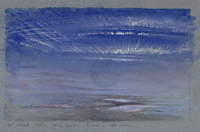Educational, manuscript (1878)
Unpublished manuscript catalogue for proposed re-organisation.

- 176. E.
- 177.
- 178. E.
- 179.
- 180. E.
- 181.
- 182. E.
- 183.
- 184. E.
- 185.
- 186. E.
- 187.
- 188. E.
-
189.
The student will be surprised at first by the placing of this Example in the group of domestic animals . If he will recollect Horace's measure of contented possession:- Unius sese dominum fecisse lacertæ , he may feel that the lizard is indeed the best of all introductions to the races of living creatures meant for our companions. It may farther interest him to hear that when I was an undergraduate I was formally invited by Dr. Buckland to his house in 'Tom Quadrangle', Ch.Ch. to breakfast with some polite little green lizards; I think from Carolina, where their duty is to keep the flies off the plates. The mystic meaning of Carpaccio in placing his own signature in the charge of animals is illustrated in my Lectures. What the creature which ought to be domestic may become, if we neglect it, is seen in the example below.
E.
-
 190.
190.
St. George's bird, the Porphyrio, from Carpaccio's picture in the church of San Giorgio de' Schiavoni. at Venice . See my Shrine of the Slave, and Mr. Anderson's following essay, The Place of Dragons.
This series is unarranged after this, except only 198, 199, 200.
- 191. E.
- 192.
- 193. E.
- 194.
- 195. E.
- 196.
- 197. E.
-
 185
198.
185
198.
Cattle by Turner: quite insuperable in perfection of rapid sketching. What the qualities of the cattle are I will not venture to say.
-
187-8
199.
Studies of the Pig, by Bewick; entirely magnificent. See the enlargement of the little one in front of the group, second from the bottom, in ‘Aratra Pentelici.
-
1.
A little music.
-
2.
A windy day at the sea-side.
200.
First sketches for:
Leech.
I place these drawings reverently with Turner's workand Bewicks, equal to either of them in execution, sofar as they go. [They can only claim their placehere for the sake of the sky-terrier, and yet they arepartly well placed in a deeper sense; for the master always regards Man himself in little higherlight than that of the most amiable and amusing of domestic animals.] They represent a powerof the English mind to which we certainly owe partof our greatness and, I believe, still more ofE.our Virtue. It is becoming every day a matter ofgreater interest to me, as a moral and metaphysical question, to determine the share which Englishhumour has in completing our courage and affection,in enabling us to bear hardship with a smile andconvey reproof in play. I believe the total wantof this faculty in the Italian mind to be at theroot of much of its cruelty, and to give moredangerous languor to its vices; and I would haveendeavoured, for many such reasons, to multiplyexamples of John Leech's work in this Collection,but that I know too sorrowfully know that, if Idid so, my younger pupils would look at nothing else. They cannot look at these two pieces,however, with too frequent and reverent attention; forthey will explain to them much of what they cannotat present understand in Turner's pencil-drawing.They will continually find me praising such andsuch pieces of Sketching as consummate, withoutperceiving in them anything more than anybodyelse could do. But that is because they havenever looked at rocks, trees, or clouds enough torecognise the likeness of them, while they haveE.looked at people enough themselves to comprehendin a moment what the drawing indicates. They feelat once, for instance, the firm standing of the tallgentleman on the left, in the upper piece, and theharmony of that attitude with the more or less muscular outline of this figure; they feel also in a moment the infirm standing of a gentleman in spectacles opposite him, and the harmony of that position with the evidently thin and undeveloped anatomy of his frame and uncertain expression ofhis face; but they would never recognise in aTurner foreground the lines of similar precisionwhich would distinguish the stability and bendingstrength of a rock of Gneiss from the fissuredcrumbling of a piece of sandstone, or the relation of the forms of a tree-stem to the actionof its haunches and looseness or density of itsfoliage. They supply, with ready imagination, inthe lower subject, the folds of petticoats troubledby the breeze, and the colour of faces contendingwith it, but would be totally helpless to complete, having only the same number of linesgiven them, the wreaths of the storm-cloud suggestedE.by Turner with equal faithfulness, or to rejoice inthe lines with which they were meant to be illumined.






